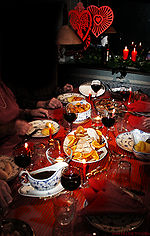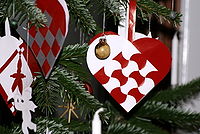
Jul (Denmark)
Encyclopedia

Christmas
Christmas or Christmas Day is an annual holiday generally celebrated on December 25 by billions of people around the world. It is a Christian feast that commemorates the birth of Jesus Christ, liturgically closing the Advent season and initiating the season of Christmastide, which lasts twelve days...
, is celebrated throughout December starting either at the beginning of Advent
Advent
Advent is a season observed in many Western Christian churches, a time of expectant waiting and preparation for the celebration of the Nativity of Jesus at Christmas. It is the beginning of the Western liturgical year and commences on Advent Sunday, called Levavi...
or on December 1 with a variety of traditions. Christmas Eve
Christmas Eve
Christmas Eve refers to the evening or entire day preceding Christmas Day, a widely celebrated festival commemorating the birth of Jesus of Nazareth that takes place on December 25...
, Juleaften,, the main event of Yule, is celebrated on evening of December 24, the evening before the two Christmas holidays, December 25 and 26th. Celebrating on the eve before the holiday is also used for most other holidays in Denmark.
Jule Eve
In the evening an elaborate dinner is eaten with the family. It usually consists of roast pork, roast duck, roast goose or stuffed turkey with potatoes, caramelized potatoes, red cabbage and plenty of brown gravyBrown sauce (meat stock based)
In classical French cuisine, a brown sauce generally refers to a sauce with a meat stock base, thickened by reduction and sometimes the addition of a browned roux, similar in some ways to but more involved than a gravy...
. For dessert, risalamande
Risalamande
Risalamande is a traditional Danish dessert typically served at Christmas.Risalamande was created in the last part of the 19th century...
, a cold rice pudding dish is served with a hot cherry sauce, traditionally with a whole almond hidden inside. The lucky finder of this almond is entitled to a small gift. In some families, it's tradition that the rice pudding dessert is made with the remaining rice porridge from the previous evening, a meal served on the 23rd, Lillejuleaften (Little Yule Eve), with cinnamon, brown sugar and butter. It is eaten warm with a fruit drink or sweet malt beer.
After the meal is complete, the family will dance around the Juletræ and sing Yule songs and carols (the latter becoming less popular). When the singing is complete, presents which are tucked under the tree, are handed out by the children or in turn. After they have been opened, there are more snacks, candy, chips and sometimes the traditional Gløgg.
Church visits
In Denmark there is a tradition to go to Church before Christmas Eve, on the 24th. The text is Luke 2Luke 2
Luke 2 is the second chapter of the Gospel of Luke in the New Testament of the Christian Bible. It contains an account of Jesus's birth and an incident from his childhood.- Jesus's Birth :...
, but since the 24th is not an official Christmas holiday, there was no official ritual for that day until recently.
Most churches have Christmas services on both official Christmas holidays, 25th and 26th of December, with well defined rituals.
Going to church is becoming less popular in current day Denmark, however.
Yule lunches
Throughout the Yule period, a range of Yule dinners or lunches are arranged. Before December 24 most workplaces, unions, schools, football teams, or extended groups of friends arrange a Julefrokost (Yule Lunch), but sometimes they are delayed until January. This typically involves plenty of food and alcohol, and often takes place on a Friday or Saturday night.After December 24, usually on first or second day of Yule (the Christmas holidays), the extended families arrange a familiejulefrokost (Family Yule Lunch). This usually involves more food, and takes place from noon until evening.
An average Dane usually attends three to four julefrokoster and one or two familiejulefrokoster during Jul.
A typical Yule Lunch involves lots of beer and snaps
Akvavit
Akvavit or aquavit is a traditional flavoured spirit that is principally produced in Scandinavia, where it has been produced since the 15th century....
. It begins with a variety of fish courses, open face sandwiches with herring, and deep fried plaice filet with remoulade
Remoulade
Remoulade or rémoulade, invented in France, is a popular condiment in many countries. Very much like the tartar sauce of some English-speaking cultures, remoulade is often aioli- or mayonnaise-based. Although similar to tartar sauce, it is often more yellowish , often flavored with curry, and...
. Herring courses can include pickled or curried herrings on rugbrød
Rugbrød
Rugbrød is a very commonly used bread in Denmark. The common rugbrød usually resembles a long brown rectangle, no more than 12 cm high, and 30–35 cm wide, although shapes and sizes may vary, as well as the ingredients...
(Danish flat whole grain rye bread). The fish course usually also include smoked eel and smoked salmon. Next will be a variety or warm and cold meats, such as sausages, fried meatballs, boiled ham, and liver paté, served with red or green braised cabbage dishes. Desserts are usually cheeses and rice pudding. From time to time, someone calls out "Skål" to make a toast, and everyone stops eating to take a drink. Normally, everyone takes public transportation to the event, so that no one has to drive home after this traditional party.
Yule Calendars
Denmark has adopted and expanded the German tradition of Advent calendarAdvent calendar
An Advent calendar is a special calendar which is used to count or celebrate the days of Advent in anticipation of Christmas. Some calendars are strictly religious, whereas others are secular in content...
s. It is common to have Julekalender (Yule calendars) that mark all days from December 1 until December 24. They are often made of cardboard with pictures or treats such as chocolate. They come in various forms whether home-made to or manufactured and can contain innocent stories of Yule or might even be scratchcard
Scratchcard
A scratchcard is a small card, often made of thin paper-based card for competitions and plastic to conceal PINs, where one or more areas contain concealed information which can...
s.
A popular version is the gavekalender (gift calendar). These can either function as a julekalender marking all 24 days up to Yule Eve with a gift for each day or they can function as Advent calendars marking the four Sundays of Advent instead with a gift for each Sunday.
A special Danish calendar tradition started by DR
Danmarks Radio
DR – officially rendered into English as the Danish Broadcasting Corporation – is Denmark's national broadcasting corporation. Founded in 1925 as a public-service organization, it is today Denmark's oldest and largest electronic media enterprise...
in 1962 consists of broadcasting TV shows with exactly 24 episodes, one each day up to Yule Eve. The tradition has become very popular and every major network now has TV calendars during the Christmas period, whether original productions or TV shows. The tradition of TV calendars has also been adopted by the other Scandinavian countries.
Yule vacation
Because of the high concentration of holidays at the end of December, it is possible to have a vacation between Christmas and New Year without taking a lot of days off from work. This holiday is usually named "Juleferie" or Yule Vacation, and is usually considered to be in the date range from December 24 until approximately January 1.Other traditions

Santa Claus
Santa Claus is a folklore figure in various cultures who distributes gifts to children, normally on Christmas Eve. Each name is a variation of Saint Nicholas, but refers to Santa Claus...
is known as Julemanden
Julemanden
Julemanden can be directly translated to "The Yule-Man" or "The Christmas-man". In modern Danish culture Julemanden is the equivalent of the English Father Christmas although the roots of the character reach into Danish folklore and mythology wherein Julemanden is a mythical character who is said...
(literally "the Yule Man") and is said to arrive on a sleigh drawn by reindeer, with presents for the children. He is assisted with his Yuletide chores by elves known as julenisser (or simply nisser
Tomte
A tomte , nisse or tonttu is a mythical creature of Scandinavian folklore. The tomte or nisse was believed to take care of a farmer's home and children and protect them from misfortune, in particular at night, when the housefolk were asleep...
), who are traditionally believed to live in attics, barns or similar places. In some traditions, to maintain the favor and protection of these nisser, children leave out saucers of milk or rice pudding or other treats for them on the afternoon on the 24th, and are delighted to find the food gone on Yule morning.
Danish homes are decorated with kravlenisser (climbing nisse), which are cardboard cutouts of nisser
Tomte
A tomte , nisse or tonttu is a mythical creature of Scandinavian folklore. The tomte or nisse was believed to take care of a farmer's home and children and protect them from misfortune, in particular at night, when the housefolk were asleep...
which can be attached to paintings and bookshelves. This is a unique Danish tradition started in the early 20th century.
Julehjerter or pleated Yule hearts are handmade decorations which are hung on the Yule tree. Children together with other members of the family create the hearts from glossy paper in various colours.
St. Lucia Day
St. Lucia Day
Saint Lucy's Day or the Feast of St. Lucy is the Church feast day dedicated to St. Lucy and is observed on December 13. Its modern day celebration is generally associated with Sweden and Norway but is also observed in Denmark, Italy, Latvia, Estonia, Finland, Hungary, Malta, Bosnia, Bavaria,...
is celebrated on December 13.
History
Until 1770, the Christmas holidays included 3rd day of Christmas (December 27) and Epiphany on January 6 (celebrated on the eve of January 5). Afterwards, only 1st and 2nd Christmas Day are holidays, and January 6 is now a celebration day.See also
- YuleYuleYule or Yuletide is a winter festival that was initially celebrated by the historical Germanic people as a pagan religious festival, though it was later absorbed into, and equated with, the Christian festival of Christmas. The festival was originally celebrated from late December to early January...
- Jul (Norway)
- Christmas worldwideChristmas worldwideThe Christmas season is celebrated in different ways around the world, varying by country and region. Elements common to many areas of the world include the lighting of Christmas trees, the hanging of wreaths, Christmas stockings, candy canes, and/or the creation of Nativity scenes depicting the...
- Julenisse
- JulemandenJulemandenJulemanden can be directly translated to "The Yule-Man" or "The Christmas-man". In modern Danish culture Julemanden is the equivalent of the English Father Christmas although the roots of the character reach into Danish folklore and mythology wherein Julemanden is a mythical character who is said...
- JuhlJuhlJuhl is a surname originating in Denmark. It is most common in Denmark and the USA. .-Pronunciation:In Danish, "Juhl" is pronounced 'yool' or 'yooh'....
(surname)

